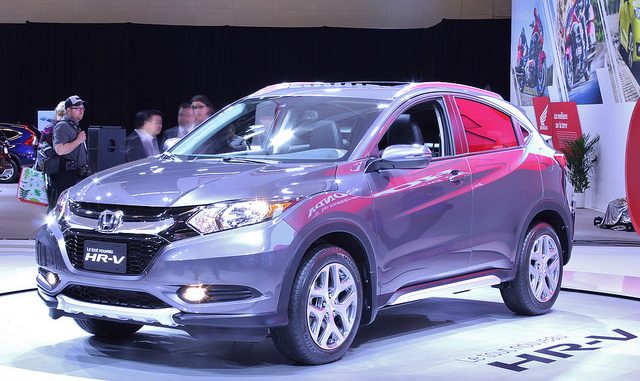
Automaker aims for big space, strong fuel economy in a small package

Honda Canada is leaping into a growing market segment with its all-new compact crossover, the 2016 HR-V.
Available in spring of this year, though no on-sale date has been announced, the HR-V was introduced to Canada this week at the Montreal International Auto Show.
Based on the Fit hatchback, the HR-V takes its name from a similar-sized utility vehicle sold in Japan from 1999 to 2006. With this latest introduction, Honda will now have three utility vehicles spanning the size scale–the CR-V, Pilot and now HR-V.
The HR-V avoids a boxy body with help from a coupe-like roofline and discreet rear door handles, accentuated by a diagonal slash in the vehicle’s side panels. The front end shares design elements with its parent vehicle, the Fit.
Under the hood is a 1.8-litre 4-cylinder engine making 138 horsepower and 127 foot-pounds of torque, mated to a six-speed manual–available in 2-wheel drive models only–or the company’s continuously variable transmission (CVT), which is standard on all-wheel-drive models.
That transmission style is growing in popularity as automakers seek to meet federally-mandated fuel economy targets. Honda’s CVT started life in the Accord before being offered in the Civic and the Fit.

“Our new sport CVT … is programmed in such a way that you don’t have that ‘rubber band’ feel,” said Hayato Mori, senior manager of product planning & business development at Honda Canada.
“We geared it in such a way that it almost feels like a regular automatic transmission, though it has all of the efficiency of a CVT.”
The HR-V’s versatile cargo area, featuring the company’s reconfigurable second-row ‘Magic Seat’–made famous in the Fit–and 1660 litres of cargo volume, literally puts the vehicle in a class above, said Mori.
“Because of the fold down seats and the Magic Seats … the volume of the HR-V is actually one class above–it’s actually CR-V class in terms of cargo space in what’s basically a Fit platform.”
Versatility and value is key to capturing market share in a hotly contested field, though the compact crossover market is currently sparse–for now. Mori expects it to grow substantially in the coming years.
“Right now there are very few players, so with us, we wanted to make sure our vehicle had some of the shortcomings addressed,” said Mori, referring to the biggest complaints of small utility vehicles–space, power and fuel economy.
Mori said the company expects to achieve best-in-class fuel economy with the HR-V. Though no mileage figures were available at the media viewing, the U.S. Environmental Protection Agency (EPA) released them the next day.

The HR-V is rated at 28 miles per gallon (U.S.) in the city and 35 on the highway for the 2-wheel drive model equipped with CVT, with a combined rating of 31MPG. That works out to 6.7 L/100km on the highway and 7.6 L/100km combined.
All-wheel-drive models see a slight decrease in fuel economy, with a rating of 7.35 L/100km on the highway and 8.1 L/100km combined.
In comparison, the Chevrolet Trax–a close competitor–is rated at 7.6 L/100km highway for all-wheel-drive models, and 6.9 litres/100km highway for front-wheel-drive models.
Photographs by Steph Willems

Be the first to comment